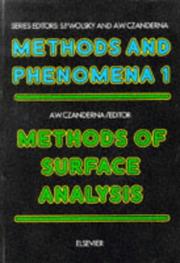| Listing 1 - 3 of 3 |
Sort by
|
Book
ISBN: 3540080783 0387080783 3642811019 3642810993 9783540080787 Year: 1977 Volume: 4 Publisher: Berlin Springer
Abstract | Keywords | Export | Availability | Bookmark
 Loading...
Loading...Choose an application
- Reference Manager
- EndNote
- RefWorks (Direct export to RefWorks)
Experimental solid state physics --- 543.54 --- Capillary analysis. Adsorption analysis. Stalagmometry. Chromatography. Electrophoresis --- 543.54 Capillary analysis. Adsorption analysis. Stalagmometry. Chromatography. Electrophoresis --- ELECTRON SPECTROSCOPY --- SURFACE (TECHNOLOGY) --- ANALYSIS

ISBN: 0444413448 0444596453 9780444413444 Year: 1975 Volume: v. 1 Publisher: Amsterdam Elsevier
Abstract | Keywords | Export | Availability | Bookmark
 Loading...
Loading...Choose an application
- Reference Manager
- EndNote
- RefWorks (Direct export to RefWorks)
543.54 --- Surfaces (Technology) --- -Characterization of surface --- Surface analysis --- Surface characterization --- Chemistry, Analytic --- Surface chemistry --- 543.54 Capillary analysis. Adsorption analysis. Stalagmometry. Chromatography. Electrophoresis --- Capillary analysis. Adsorption analysis. Stalagmometry. Chromatography. Electrophoresis --- Analysis --- -543.54 Capillary analysis. Adsorption analysis. Stalagmometry. Chromatography. Electrophoresis --- Characterization of surface --- Surfaces (Technologie) --- -Capillary analysis. Adsorption analysis. Stalagmometry. Chromatography. Electrophoresis --- Radiochemical analysis --- Applied chemical analysis --- Experimental solid state physics --- Spectrometric and optical chemical analysis --- fysicochemie --- Materials sciences --- Analysis. --- Analyse --- Analytical chemistry --- Photoelectron spectroscopy. --- Mass spectrometry. --- Surface chemistry. --- Surfaces (technologie) --- Spectroscopie de photoélectrons --- Spectroscopie de masse. --- Chimie des surfaces --- Surfaces (Technology) - Analysis --- Spectroscopie de photoélectrons

ISBN: 0387005927 9780387005928 1441918337 1280188944 9786610188949 0387216561 Year: 2004 Publisher: New York, NY : Springer,
Abstract | Keywords | Export | Availability | Bookmark
 Loading...
Loading...Choose an application
- Reference Manager
- EndNote
- RefWorks (Direct export to RefWorks)
As I glance out my window in the early morning, I can see beads of droplets gracing a spider web. The film of dew that has settled on the threads is unstable and breaks up spontaneously into droplets. This phenomenon has implications for the treatment of textile fibers (the process known as "oiling"), glass, and carbon. It is no less important when applying mascara! I take my morning shower. The moment I step out, I dry off by way of evaporation (which makes me feel cold) and by dewetting (the process by which dry areas form spontaneously and expand on my skin). As I rush into my car under a pelting rain, my attention is caught by small drops stuck on my windshield. I also notice larger drops rolling down and others larger still that, like snails, leave behind them a trail of water. I ask myself what the difference is between these rolling drops and grains of sand tumbling down an incline. I wonder why the smallest drops remain stuck. The answers to such questions do help car manufacturers treat the surface of glass and adjust the tilt of windshields.
Capillarity. --- 624.131.523 --- Hydrodynamic forces. Uplift. Capillary pressure. Buoyancy. Pore water pressure --- 624.131.523 Hydrodynamic forces. Uplift. Capillary pressure. Buoyancy. Pore water pressure --- Capillarity --- 532.6 --- 543.54 --- Matter --- Physics --- Permeability --- Surface chemistry --- Surface tension --- 532.6 Surface phenomena. Surface tension. Capillarity --- Surface phenomena. Surface tension. Capillarity --- 543.54 Capillary analysis. Adsorption analysis. Stalagmometry. Chromatography. Electrophoresis --- Capillary analysis. Adsorption analysis. Stalagmometry. Chromatography. Electrophoresis --- Properties --- Continuum physics. --- Fluid mechanics. --- Physical chemistry. --- Materials—Surfaces. --- Thin films. --- Classical and Continuum Physics. --- Engineering Fluid Dynamics. --- Physical Chemistry. --- Surfaces and Interfaces, Thin Films. --- Films, Thin --- Solid film --- Solid state electronics --- Solids --- Surfaces (Technology) --- Coatings --- Thick films --- Chemistry, Theoretical --- Physical chemistry --- Theoretical chemistry --- Chemistry --- Hydromechanics --- Continuum mechanics --- Classical field theory --- Continuum physics
| Listing 1 - 3 of 3 |
Sort by
|

 Search
Search Feedback
Feedback About UniCat
About UniCat  Help
Help News
News